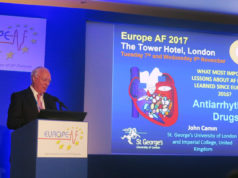
Preliminary data from the AFACART (Non-invasive mapping before ablation for atrial fibrillation) study have shown encouraging results when treating persistent atrial fibrillation with non-invasive mapping followed by pulmonary vein isolation and/or linear lesions.
After a mean follow-up of 6±3 months, 83% of the patients were completely free from atrial fibrillation and 72% were off antiarrhythmic drugs, reported Sebastien Knecht (CHU Brugmann, Bruxelles, Belgium), principal investigator of the study, at the 10th International Symposium on Catheter Ablation Techniques (ISCAT; 15–17 October, Paris, France).
“Ablation for persistent atrial fibrillation remains technically challenging and time consuming with highly variable outcomes and long-term benefit best described as modest. Better understanding of patient-specific electrophysiological substrate might allow for more targeted ablation,” noted Knecht. “Non-invasive mapping using the ECVUE system (CardioInsight) can identify atrial fibrillation drivers (rotors and focal sources). Therefore, [with the AFACART study] we sought to determine if targeting these sites for ablation (followed by PV isolation ± linear lesions) would result in higher chances of acute atrial fibrillation termination and good chronic outcome.”
ECVUE consists of a vest with 252 electrode body surface electrograms. Explaining the ablation protocol for this European, multicentre, feasibility, non-randomised study, Knecht said that prior to the ablation procedure these 252 electrodes were placed on the patients’ torso and were connected to the CardioInsight system, which records arrhythmia disturbances. Then the patients underwent a CT scan (no contrast) to image both the heart and the electrodes on the patients’ torso. The CT scan images were then segmented to obtain epicardial anatomy and to establish heart-torso geometry. The electrograms produced were processed by the system to identify atrial fibrillation drivers. All patients then went on to undergo pulmonary vein isolation. If atrial fibrillation had yet to terminate, linear lesions (roof, mitral, CTI) were performed. Knecht noted that DC cardioversion was the last step in cases where atrial fibrillation did not terminate during ablation.
The primary endpoint of the study is acute termination of atrial fibrillation to sinus rhythm or stable (>5min) atrial tachycardia during ablation. Secondary endpoints are reduction in radiofrequency and procedure time compared to standard of care based on historical control patients, and freedom from persistent atrial fibrillation at the end of 12-months follow-up.
The study enrolled 118 patients with persistent atrial fibrillation refractory to drugs or patients with persistent atrial fibrillation for ≤12 months at eight European centres.
Knecht said that preliminary results showed that acute termination of atrial fibrillation occurred in 64% of patients treated with a rotor only ablation strategy, in 66% of patients treated with rotor ablation and pulmonary vein isolation and in 73% of patients treated with a rotor, pulmonary vein isolation and linear lesions ablation strategy.
Total time to atrial fibrillation termination was 44.7±32.2min, radiofrequency time was 70.3±28.5min, fluoroscopy time was 30±13.2min and procedure time was 211±74.4min. He noted that “none of the centres had any practical experience with the system before the study.”
Knecht told Cardiac Rhythm News: “The results of the AFACART study are encouraging and comparison with other methods of performing ablation for persistent atrial fibrillation is the subject of this on-going study.”
Follow-up of all patients up to one year will be completed in July 2015. “This will ultimately confirm that the favourable acute atrial fibrillation termination rate corresponds to better chronic outcomes. The procedural data will also be compared to a historical control cohort (who underwent stepwise ablation),” Knecht noted.
He also highlighted that novel tools like ECVUE seem more specific to localise active sources during atrial fibrillation and are probably the future for substrate ablation during atrial fibrillation.









